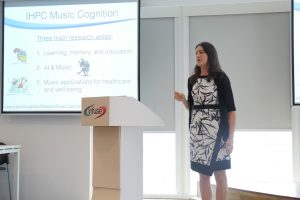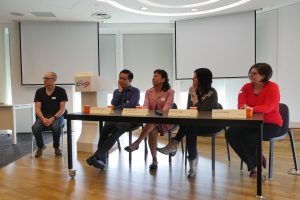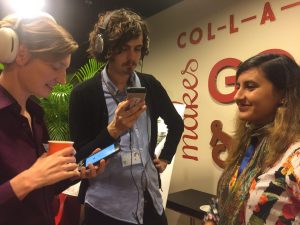One of the things that I noticed when I arrived in Singapore six months ago was that there was lots of interesting music research going on here. I enjoy reaching out and talking shop with folks so I spent my first month visiting various academic and research institutions (e.g., NUS, SUTD, A*Star). I also noticed that folks seemed to be working in relative isolation and were not always aware that others in Singapore were doing interesting and relevant work.

Back home in the northeast United States, I have been very involved with developing the local music information retrieval community. Unlike in Europe where there are big music-IR labs (e.g., MTG in Barcelona, C4DM in London, IRCAM in Paris, OFAI in Austria), music-IR researchers in North America tend to operate as solo faculty members with a small cadre of enthusiastic students. As such we have had to be a bit creative to survive.
One example of this is the North East Music Information Special Interest Group (NEMISIG) workshop that was started 10 years ago in 2008. The goal of the workshop is simply to get all of the labs in the region together on a regular basis to talk about what we are doing and to look for opportunities to collaborate. In 2013, Colin Raffel had the idea of adding a “Hackathon for Audio and Music Research” (HAMR) to NEMISIG so that grad students could spend some focused quality time working on creative research projects with one another. The HAMR model has since been adopted by our larger International Society for Music Information Retrieval (ISMIR) conference for the past few years.

Based on my positive experience with NEMISIG, I thought that something like this might be a good idea for Singapore. I started bouncing this idea around and it turned that my friend Kat Agres at A*Star had already proposed a similar idea but for a broader music research community. This included music cognition, music-IR, music theory, and innovative music technology startups in the area.
This past Friday, Kat and her team hosted the first “Singapore Music Research Symposium” at A*Star. It featured great talks on everything from choral singing to prevent dementia to deep neural networks for parameterized sound modeling to conducting artistic research within a music conservatory. There were posters and demo, a panel, a brainstorming session, and plenty of tea break discussions.

All and all, the symposium was a great success. The number one comment that I heard was some variant of “Wow, I can’t believe that so many other people in Singapore are doing such interesting and related music research.” Simply being aware that others have similar interests is the first step in creating a sustainable research community.
ps – At the end of the workshop, there were two great music performances. The first was by Prof. Bernard Lanskey who focused on his lifelong relationship with Mozart’s Fantasy in C Minor. The second was a highly-stylized performance by Prof. Stephen Lim who introduced many of us to the Electone for the first time. The sonic soundscape that he was able to produce with this new age synthesizer was crazy cool.
